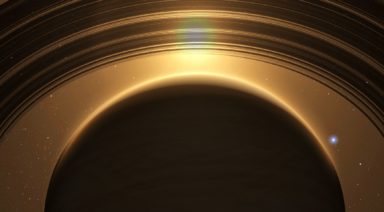Asgardia: The Space Nation Now Accepting Citizenship Applications

Elon Musk is trying to get to Mars, Japan wants to build a space elevator, and now a Russian billionaire wants to start a nation in low-earth orbit. Named after the Norse city in the sky, Asgardia dreams to be a utopian nation floating around Earth, where science and technology can flourish without being inhibited by the mundane goings-on down below.
Igor Ashurbeyli, an aerospace engineer from Azerbaijan, proposed the creation of Asgardia and quickly gained a following. Now, with nearly 200,000 “citizens,” he’s hoping to be accepted by the U.N. as a recognized nation in the world – the 173rd largest at time of writing.
Recently, Ashurbeyli partnered with NASA to successfully launch a satellite into orbit called the Asgardia-1. But the satellite was a small step in accomplishing the lofty goal of building habitable platforms for Asgardians at some point in the future.
Asgardia-1 is roughly the size of a loaf of bread, containing half a terabyte of pictures, names, the Asgardian constitution, and a coat of arms. It will orbit for about a year, before falling back to Earth and burning up in the atmosphere.
Asgardia Citizenship
Becoming a citizen of Asgardia is easy, one need only submit their email address, agree to some basic terms and conditions, and build a profile. At the time of writing this, Asgardia boasts 186,530 denizens, with the majority of the populace coming from the U.S. — Turkey is a close second.
The nation is currently in the midst of its parliamentary elections on its website, Asgardia.space. There are 112 candidates vying for one of 150 seats in the conceptual nation’s legislative body. These candidates will represent 13 districts based on the most widely spoken languages of its citizens thus far. Prospective MPs don’t need to reside in the native country of the language they wish to represent, they just need to be fluent in that language – Asgardia is a borderless nation after all.
Asgardia’s citizenship has fluctuated, with initial interest numbering somewhere around half a million. That number dropped to around 114,000 last summer, but has picked up since. Citizenship simply requires one to be over the age of 18 and not have any outstanding felony convictions.
A Space Nation’s Historical Precedent
Asgardia refers to itself as a future U.N. member, though it may face some difficulty being recognized by the world’s nations. A similar space nation was proposed in 1949 by an American named James Mangan, called the Nation of Celestial Space.
Unlike Asgardia’s modest attempt to create a putative nation of orbiting satellites, Mangan’s Nation of Celestial Space, or Celestia, tried to stake the bold claim of the entirety of outer space. Needless to say, his concept failed.
But before his attempt to represent the infinite, vast expanse beyond Earth met its demise, Mangan went so far as to mint coins, design a flag, and propose a set of rules and intentions for his vast territory. The flag depicted a blue background with a white ‘#’ – the editor’s symbol for space.
Celestia’s goal was to prevent Earth’s hegemonic struggle from spilling into the cosmos, similar to Asgardia’s anti-nationalist sentiment.

He even convinced the state attorney general of Illinois that his goal was altruistic, leading to a charter for Celestia in the state’s record.
Mangan proposed legislation to make it illegal for other nations to trespass in space via rockets and satellites. He also wanted to sell Earth-sized plots of space for a dollar, so that anyone who “owned” that much space would recognize the futility and absurdity of war.
In the end, it turned out that Celestia may have been more of a self-aggrandizing marketing ploy for Mangan, rather than a genuine attempt at what Asgardia says it aims to achieve.
Asgardia Projects and Missions
Asgardia promises to be a hub for scientists and researchers to develop future space technologies, uninhibited by commercial or military influence.
It says it will be impartial in Earthly matters and affairs – something like an ethereal Switzerland. Though in much the same way people take advantage of Switzerland’s neutrality on Earth, some foresee Asgardia as being another possible tax haven for the wealthy.
But if its ostensible purpose is to be unaffiliated and detached from worldly politics and international disputes, it would seem Asgardia might stay away from tax loopholes, if it even had the option.
Another part of the Asgardian manifesto is that it will aim to protect Earth from space threats. It plans to monitor and collect space debris from satellites and rockets currently floating around Earth; track solar flares, CMEs, and cosmic radiation; monitor asteroids, comets and meteorites that may pose threats; and finally, defend against microorganisms hitching a ride on small celestial bodies that may pose biological threats to humanity.
These noble tasks sound like they would require significant resources to defend against, but if someone is willing to do it, or at least try, maybe we should let them.
The colonization of space and space exploration has seen surges in public interest through the achievements of privatized programs like SpaceX. It won’t be surprising if we continue to see support for space missions that increasingly focus on including the public and making space attainable for the average citizen.
The question is whether Asgardia’s idealistic goal of creating an all-inclusive, neutral nation, without the influence of international politics and corporate interests is readily attainable. The optimist in us would like to think so.
Nemesis Star Theory; Does the Sun Have an Evil Twin?

Many people remain anxious about the threat posed from a hidden nemesis planet, known as Nibiru, that has been prophesied to collide with Earth. Though many of the proposed dates for this collision have come and gone, there is another celestial body that may be more likely to lead to an apocalyptic event: The Nemesis Star.
The Nemesis Star Theory
Binary star systems occur frequently and are actually more common than single stars. At least that’s what we thought, until a recent hypothesis proposed the possibility that every star starts out as a binary pair or multi-pair system. While the theory hasn’t been confirmed, there is significant evidence that our Sun likely has a twin, an evil twin.
The majority of stars in the galaxy are red dwarfs, which are a fifth of the size of the sun and up to 50 times fainter. These types of stars are pretty commonly paired with another star in a binary system, leading astronomers to believe that Nemesis would be the Sun’s red dwarf star companion. But due to the small size and faintness of these stars, they can be hard to find, making Nemesis all the more elusive.

binary stars courtesy wired.com
This star is thought to be responsible for 12 cyclical extinction events on Earth, including the one that killed the dinosaurs. The Nemesis Star Theory’s roots can be traced to two paleontologists, David Raup and Jack Sepkoski, who noticed that there was a periodicity to major die-outs throughout Earth’s history, occurring in 26 million year intervals. This led to a number of astrophysicists and astronomers, postulating their own Nemesis Star hypotheses.
So how would the sun’s twin be responsible for mass extinctions? The Nemesis Star Theory proposed the idea that the Earth’s binary twin must be in a large 1.5 light-year orbit, retaining just enough gravitational pull between it and the Sun so as not to drift off. But the issue with the orbit of Nemesis is the possibility that it occasionally passes through a cloud of icy debris on the fringe of our solar system, known as the Oort Cloud.
Don’t Perturb the Oort
The Oort Cloud is a theoretical sphere that is believed to orbit our solar system, consisting of planetesimals, the small icy building blocks of planets, comets, and asteroids. These planetesimals are sticky and collide with each other until they become large enough to have a significant gravitational pull, eventually becoming as large as a moon or a planet. They also create asteroids and comets which can be knocked out of orbit and sent hurtling toward the center of the solar system, crashing into planets.
There is a binary star system that once passed close enough to nearly perturb the Oort, and it was likely visible from Earth. Scholz’s Star made a flyby some 70,000 years ago, at a distance of 50,000 astronomical units (AU), with one AU being the distance from Earth to the Sun. The Oort is thought to extend from anywhere between 5,000 and 100,000 AUs and is believed to contain up to two trillion celestial objects. Astronomers are 95% certain that Shulz’s star passed within half of a light-year of us, possibly perturbing the Oort, though apparently not enough to cause a mass extinction event.
Comets are believed to exist within the Oort and are the product of a thief model, a give-and-take of celestial bodies between stars when they’re formed. In this process, comets get pulled back and forth between the gravitational field of stars. It was for this reason that the Oort was theorized, due to the number of comets coming from it, there had to have been a sibling star that pulled them out to the Oort.

The Oort courtesy of space-facts.com
Astronomers also found a dwarf planet in the Kuiper Belt, a region just before the Oort that also contains icy, celestial bodies. This planet, named Sedna, orbits the Sun in a long, drawn-out elliptical path and is one of potentially hundreds. Sedna may help to explain the Nemesis star theory, in that its far-flung orbit was likely caused by our Sun’s twin, pulling it out as it drifted off into the depths of space. Imagine if instead of 9 planets in our solar system, there were a few hundred?
So where is this Nemesis star? Several years ago, the E.U. launched the wonderfully named, Gaia satellite, to map out the stars in the Milky Way and look specifically at stars that have had a close encounter with our solar system or that might come close in the future. But whether or not Nemesis will be found is unknown; it’s possible that it could make a return for the next mass extinction, or it is possible that it drifted off, perturbing the Oort of another star.




































